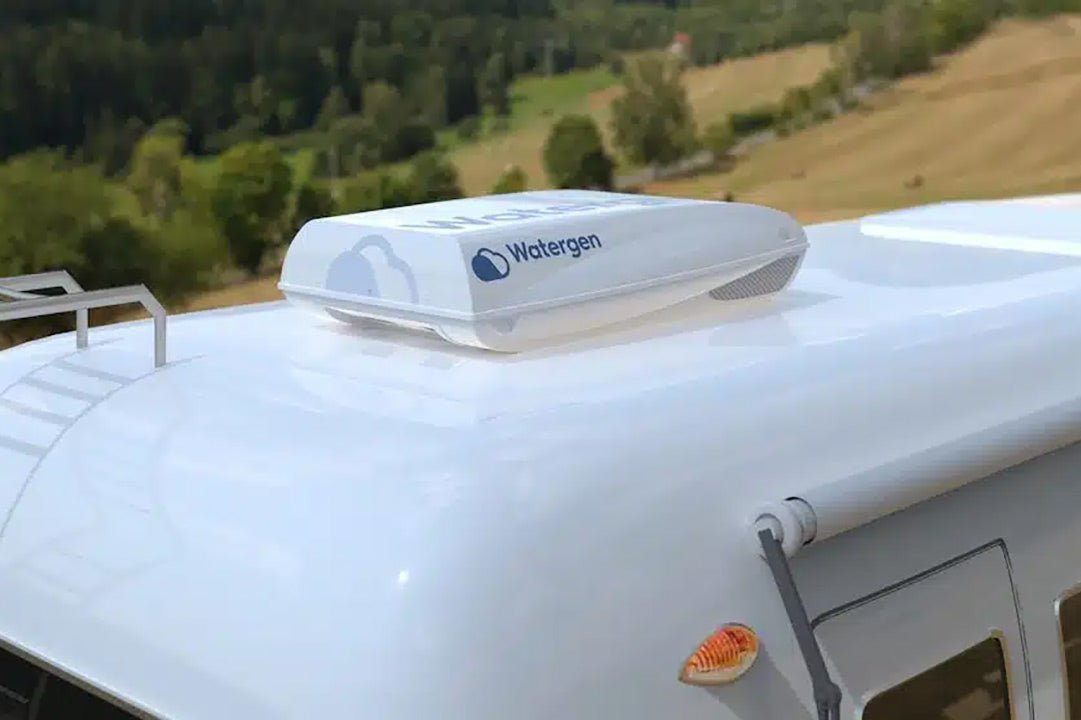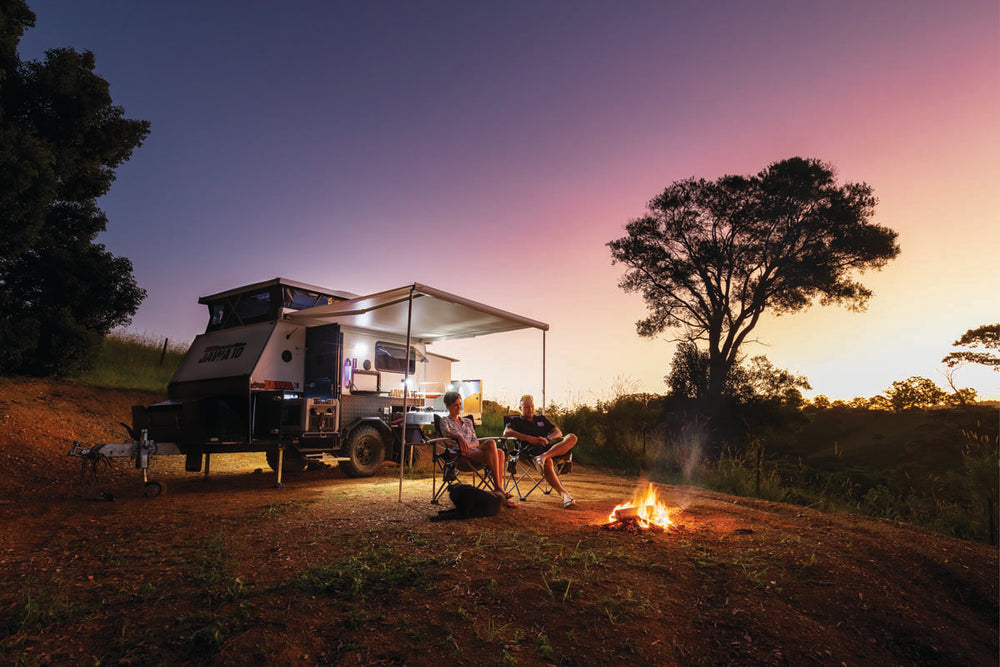

Running low on water off-grid? Watergen’s new AWG system makes water from air, but with a serious power draw, is it practical for caravanners?
Imagine you have a magic machine that can pull water out of the air — kind of like how a cold beer gets wet on a hot day; that’s water condensing from the air, and the basics of atmospheric water generators (AWG).
While the idea isn’t new, turning it into something practical and efficient for everyday use has been the challenge — until now. That’s where Watergen, an Israeli company, stands out. Founded in 2009, Watergen has developed a full range of AWG systems, from large-scale solutions for governments and businesses to residential and now mobile units. And yes, it’s coming to Australia.
At the core of Watergen’s products is its patented GENius heat-exchange technology. This system efficiently draws in air, cools it to extract water vapor and then filters and purifies the condensed water to produce high-quality drinking water. Notably, Watergen’s technology can generate water even in environments with humidity levels as low as 20 per cent.
How it works: The basics of atmospheric water generation
Watergen’s patented GENius heat-exchange technology works like this:
- It draws in ambient air through a fan.
- The air is cooled, condensing moisture into water droplets.
- These droplets collect on specially coated surfaces and are filtered, purified and mineralised to produce safe, clean water that's suitable for drinking.
What makes Watergen’s technology unique is its efficiency and versatility. It can generate high-quality water in a wide range of humidity levels — even as low as 20 per cent.


Can it work where we travel?
A quick search with the BOM suggests that the figures in the table below are the relative humidities at 3pm where we like to travel in Australia. Humidity can be higher in the early morning. I chose 3pm as it’s a relatable time of day and obviously, these are historic averages that change, like the weather …
Region |
January |
March |
May |
July |
September |
November |
Mildura, Vic |
28% |
34% |
45% |
63% |
43% |
32% |
Cooktown, Qld |
69% |
72% |
70% |
65% |
59% |
61% |
Hobart, Tas |
54% |
56% |
63% |
65% |
56% |
56% |
Adelaide, SA |
42% |
46% |
58% |
65% |
56% |
46% |
Alice Springs, NT |
22% |
24% |
26% |
35% |
25% |
19% |
Mount Isa, Qld |
32% |
32% |
31% |
28% |
19% |
22% |
Phillip Island, Vic |
61% |
60% |
70% |
73% |
66% |
64% |
Gold Coast, Qld |
69% |
67% |
62% |
56% |
61% |
68% |
Even in the dry centre of the country, Watergen’s tech shows promise.
Most AWGs are massive, industrial-sized machines designed for offices and public spaces, so not travel-friendly, but Watergen is scaling them down to sizes we can use.
Watergen will soon launch the Watergen ON Board, an AWG system specifically designed for mobile applications, including caravans. What stood out to us is the footprint of the ON Board which looks no bigger than a modern air-conditioner unit and is designed to be roof-mounted.
Operating between 15–45°C and humidity levels of 20–99 per cent, it’s engineered to handle Australia’s diverse climates.
While full specs are still under wraps, we expect it can also integrate with holding tanks. Launch is anticipated by the end of 2026.
It is all sounding great but anyone that knows what it takes to run an air-conditioner and fridges, appliances that compress gases to either heat or cool, knows how power hungry it is and the process of the GENius tech feels eerily similar, so will it chew through batteries?
 The Watergen ON Board is roughly the same size as a modern air-conditioner unit
The Watergen ON Board is roughly the same size as a modern air-conditioner unit
How power efficient is making water from air?
It’s a fair question. If it works like an air-conditioner, it might also draw power like one. Watergen claims its GENius tech can produce 1L of water using just 0.35 kWh — depending on conditions. For example:
- The Watergen Mobile Box (a portable unit for vans, boats, etc.) draws 480W (12V) at peak and about 380W (12V) at nominal, producing up to 25L per day.
- That’s roughly 9.1kW per 24 hours, or 365Wh per litre — pretty close to the larger GENius system’s benchmark.
For those that still think in amp-hours, 9.1kW equals about 780Ah at 12V.
Power-hungry? Maybe. But it’s also a new technology. Like the early days of solar and air-con, efficiency will improve, and adoption will follow.
Knowing you need to carry or offer up in-excess of 10kW to run a system like ON Board along with powering other appliances in your van is not insubstantial. If you wanted to try to run it off solar, it is possible. But remember, the sun doesn’t shine at night so these numbers might shock you too.
 The Watergen Mobile
The Watergen Mobile
Could you run an AWG off solar alone?
During the daylight hours, yes. To cover off on a draw of 450W, 750W of solar panels will do the trick during most of the day and add in some excess to your battery at peak times but does not account for non-peak times. Want to leave the water-maker on overnight? You’ll need a big battery and a lot more solar.
I tend to err on the side of caution, assuming a rated panel will supply 80 per cent of its rating for five to seven hours in summer. Doing the sums with 2.2kW of solar panels and you are getting close to being able to leave the ON Board running day and night with a big enough battery.
Running 2200W of solar for six hours gives 13.2kWh, remove 20 per cent for losses due to dusty panels and some losses in MPPT and so on, and you come to 10.56kWh. You will get a little more either side of the peak window — maybe 1.5–2kWh — so all up, on a good day, you might produce 12kWh, which is more than enough to run the ON Board day and night. Any cloudy days or shade and that goes out the window though.
So, what is all of that going to cost you?
The Watergen ON Board has not yet been priced but the Mobile has an asking price of US$3000 or $4760 Dollarydoos before shipping and taxes. The ON Board has a higher capacity and more components so we wouldn’t expect much change from US$5000. And the solar and battery system required to run it, like above? Maybe as cheap as $20,000 for a DIY setup or $30,000 for a quality setup built by a professional.
Final thoughts
AWGs are a promising technology for water generation, particularly in remote or water-scarce regions but their thirst for power is a real challenge and the reason why systems have tended to be fixed and connected to the grid.
If ON Board can reliably create 50L of water a day for around 12,000W (1000Ah at 12V), it could work for people who have big, big budgets to include over 2500W of solar, back-up generators and battery capacities of 20kWh.
In time, I expect we’ll see more options come to market and efficiency increase like we’ve seen in air-con units for caravans. Until then, only vans at the bleeding edge of technology like the Kokoda Counterstrike Vincere will employ the tech. But like all good tech, it will trickle down to the mainstream in time.
 The Kokoda Counterstrike Vincere features some cutting edge tech
The Kokoda Counterstrike Vincere features some cutting edge tech
THE NEXT STEP
If you want to learn the latest caravan news, find the most innovative new caravans and camping gear or get inspired to head off the beaten track to explore this beautiful country, subscribe to our weekly newsletter. We promise to send you only the best content.
Related articles:
Kokoda launches the Counterstrike Vincere
Prepare to go off-grid: A guide to power management







